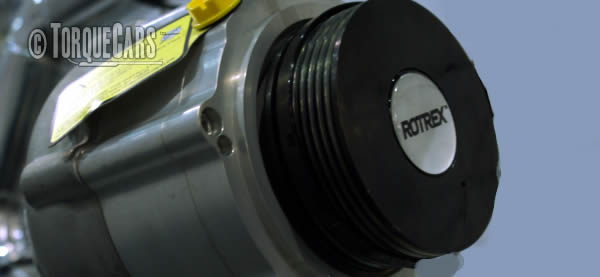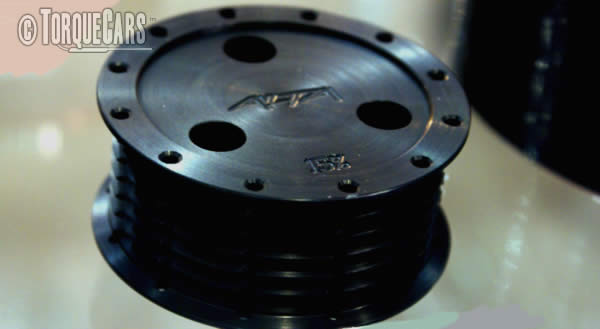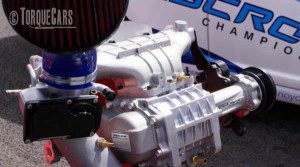Adding an aftermarket supercharger to a car
"Super stuff"
Cars use a mixture of air and fuel which must be supplied in an exact proportion.
If you can force more air into an engine you will be able to burn more fuel and this means you will make more power.
One way to get more air into an engine is by adding a supercharger which compresses the air before it goes into the engine.
This is sadly not just a "bolt on and hope it works" conversion, there are many considerations especially if you are keen to get the most power you can and want a smooth power delivery.
A supercharger offers linear power gains as it is driven by the engine. So the more RPM you have the greater the increase in compressed air.
As long as you are serious about this project and have 50 hours of qualified mechanics time to commit then go ahead.
Things are a little easier with a full aftermarket kit as all the flaws have been worked out but it still takes a lot of time, and these kits are not cheap.

Why supercharge?
Your typical NA (naturally aspirated) engine is only 60% efficient and even a highly tuned performance engine will only reach the low to mid 80% when looking at its volumetric efficiency. This is why a small engined car with a supercharger can produce similar power to a NA (naturally aspirated) engine nearly twice it's size!
A small supercharged 1.4 engine could produce 230bhp easily whereas a 2.0 NA (naturally aspirated) engine would struggle to get above 200BHP. Most tuners accept a theoretical ceiling of 100bhp per liter on a NA (naturally aspirated) engine. With a supercharger you can push way beyond this.
With more power you will hit the issue of reliability. Thankfully most modern engines are over engineered and can cope with power hikes of around 30-40% in stock form. Larger gains are on offer if you are prepared to strengthen your engine and lower the compression ratio.
Problems encountered when supercharging an engine.
Without direct injection or water cooling you will run into problems supercharging an engine with a compression ratio over 7:1. Most standard NA (naturally aspirated) engines are around 10:1 which will only tolerate low boost and it is vital that you get the fuelling and mapping spot on.
It is worth noting at this point that the ideal CR (compression ratio) and boost levels vary greatly from engine to engine so a little research is highly recommended. Some engines such as the GM Ecotec 2.2 as fitted to the Saturn Ion and Chevrolet Cobalt, is reportedly best at a CR of 10:1 and no lower than 9:1 for a supercharger conversion. Operating RPM and torque bands also come into play here along with the fuel delivery method.
Detonation or premature ignition is the biggest problem you will face adding a supercharger to your car. If the engine pressure is too great the fuel will just ignite before the spark happens with potentially catastrophic effects.
You may also find the car running rich or lean, neither of which are particularly desirable. The air flow sensor will often need to be upgraded and you must get the car fully mapped so the fuel delivery matches the delivered air.
You may also find the fuel injectors and fuel pump cannot keep up with the engines need for more fuel so these will probably need to be uprated.
You will also need to find space in your engine bay. The supercharger is driven by a belt from the crank which in most cars will also wrap around the alternator. This restricts you to citing the supercharger so the pulley is in line with this belt. It will also need to be linked to your induction piping.
You may find that relocating your battery and moving your air intake box will provide you with enough space. Some drivers place the supercharger on top of the engine and have it poking out of the front of the car.
You'll need a longer belt or another option is to run a double pulley and place a belt around this new outer pulley on the crank to drive your supercharger.
Supercharging solutions
Reducing the engine compression with lower compression pistons, and do some head and piston work etc which will allow you to run higher boost levels.
If you just want to add a supercharger and avoid internal engine work then you'll have to be content with a low boost setting.

The amount of boost from the supercharger can be controlled with a different size drive pulley. Simple gearing kicks in here and you just change the pulley size to alter the speed the supercharger runs at.
You can also avoid detonation with direct fuel injection. This helps cool the air charge and the fuel can be added much later in the squish cycle. Alternatively water injection can help dampen down and cool the air charge.
Higher octane fuel is also more resistant to knock so you should expect to switch to the highest octane fuels to protect your engine and keep everything running within parameters.
Other considerations

Get the head flowed, and a 3 or 5 angle valve job to maximise the air flow into the engine. big valve conversion can also make a difference and there is a big chance that your stock air box is now a restriction so you'll need to look at the induction filter and upgrade this along with the exhaust.
A professional tune/remap is essential. Many cars ECU's will just go into a limp home mode when it detects the unusual amount of extra air coming into the engine. This should be set up on a rolling road.
Be careful with aftermarket ECU's as some of these do not have knock sensors and on a project like this is not a risk we at TorqueCars would be willing to take.
Your clutch and gearbox may also need to be uprated to cope with the extra power. In extreme cases where you significantly move the power band you may also need to alter the gearing to take full advantage of this.
Our top tip is to get a supercharger from a breakers yard and use this as the basis for your project, a new supercharger costs a fortune.
We are starting to see some of our members adding superchargers to turbo charged engines with very impressive results, this is known as twin charging.
TorqueCars suggest that you join the friendly tuning forum and get some specific tips and advice for supercharging your car model.
Please Check out my YouTube channel, we're regularly adding new content...
PLEASE HELP: I NEED YOUR DONATIONS TO COVER THE COSTS OF RUNNING THIS SITE AND KEEP IT RUNNING. I do not charge you to access this website and it saves most TorqueCars readers $100's each year - but we are NON PROFIT and not even covering our costs. To keep us running PLEASE Donate here
If you liked this page please share it with your friends, drop a link to it in your favourite forum or use the bookmarking options to save it to your social media profile.
Feedback - What do You Think?
Please use our forums if you wish to ask a tuning question, and please note we do not sell parts or services, we are just an online magazine.
Help us improve, leave a suggestion or tip
Please watch this video and subscribe to my YouTube channel.
One Response to “Adding a supercharger”

 Click to accept YouTube Cookies & Play.
Click to accept YouTube Cookies & Play.
this was very helpful I could use all this in the future and would probly need your help to get specific parts so I don’t blow my engine as soon as I turn my car on